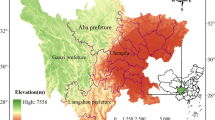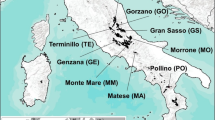Abstract
Socioeconomic changes in many areas in the tropics have led to increasing urbanization, abandonment of agriculture, and forest re-growth. Although these patterns are well documented, few studies have examined the drivers leading to landscape-level forest recovery and the resulting spatial structure of secondary forests. Land cover transitions from agricultural lands to secondary forest in the island of Puerto Rico have been ongoing since the 1940s. This study is a glimpse into this landscape level trend from 1991 to 2000. First, we relied on Landsat images to characterize changes in the landscape structure for forest, urban, and agricultural land classes. We found that although forest cover has increased in this period, forest has become increasingly fragmented while the area of urban cover has spread faster and become more clustered. Second, we used logistic regression to assess the relationship between the transition to forest and 21 biophysical, socioeconomic, and landscape variables. We found that the percentage of forest cover within a 100 m radius of a point, distance to primary roads and nature reserves, slope, and aspect are the most important predictors of forest recovery. The resulting model predicts the spatial pattern of forest recovery with accuracy (AUC-ROC = 0.798). Together, our results suggest that forest recovery in Puerto Rico has slowed down and that increasing pressure from urbanization may be critical in determining future landscape level forest recovery. These results are relevant to other areas in the tropics that are undergoing rapid economic development.



Similar content being viewed by others
References
Arroyo-Mora JP, Sanchez-Azofeifa A, Rivard B, Calvo JC, Janzen DH (2005) Dynamics in landscape structure and composition for the Chorotega region, Costa Rica, from 1960 to 2000. Agric Ecosyst Environ 106:27–39. doi:10.1016/j.agee.2004.07.002
Birdsey RA, Weaver PL (1982) The forest resources of Puerto Rico resource bulletin SO-85, USDA Forest Service. Southern Forest Experiment Station, New Orleans
Brandeis TJ, Helmer EH, Oswalt SN (2007) The status of Puerto Rico’s forests, 2003 Resour Bull SRS-119 Asheville, NC: US Department of Agriculture Forest Service, Southern Research Station, 72 pp
Chang CY, Tsai BW (2002) Land use/cover change in Taiwan in China (Taipei) IGBP Committee, Academia Sinica; National Science Council, Executive Yuan; National Taiwan University; National Central University; and National Sun Yat-sen University Global Change Research in Taiwan: The China-Taipei IGBP National Report
Chazdon RL (2003) Tropical forest recovery: legacies of human impact and natural disturbances. Perspect Plant Ecol Evol Syst 6:51–71. doi:10.1078/1433-8319-00042
Chinea JD (2002) Tropical forest succession on abandoned farms in the Humacao Municipality of eastern Puerto Rico. For Ecol Manag 167:195–207. doi:10.1016/S0378-1127(01)00693-4
Chinea JD, Helmer EH (2003) Diversity and composition of tropical secondary forests recovering from large-scale clearing: results from the 1990 inventory in Puerto Rico. For Ecol Manag 180:227–240
Collins SM, Bosworth BP, Soto-Class MA (2006) The economy of Puerto Rico: restoring growth. Brookings Institution Press, Washington
Daly C, Helmer EH, Quinones M (2003) Mapping the climate of Puerto Rico, Vieques Culebra. Int J Climatol 23:1359–1381. doi:10.1002/joc.937
Dupouey JL, Dambrine E, Laffite JD, Moares C (2002) Irreversible impact of past land use on forest soils and biodiversity. Ecology 83:2978–2984
Franco PA, Weaver PL, Eggen-Mcwentosh S (1997) Forest resources of Puerto Rico, 1990 Resour Bull SRS-22, USDA Forest Service, Southern Research Station, Ashville, pp 45
Gould WA, Edwards B, Fevold B, Martinuzzi S (2005) Fisiografía del Archipiélago de Puerto Rico Map No 2005–2 USDA Forest Service. International Institute of Tropical Forestry, Rio Piedras
Grau HR, Aide TM, Zimmerman JK, Thomlinson JR, Helmer EH, Zou X (2003) The ecological consequences of socioeconomic and land use changes in post-agriculture Puerto Rico. Bioscience 53:1159–1168
Guariguata MR, Ostertag R (2001) Neotropical secondary forest succession: changes in structural and functional characteristics. For Ecol Manag 148:185–206. doi:10.1016/S0378-1127(00)00535-1
Hecht SB, Kandel S, Gomez I, Cuellar N, Rosa H (2006) Globalization, forest resurgence, and environmental politics in El Salvador. World Dev 34:308–323
Helmer EH (2000) The landscape ecology of tropical secondary forest in montane Costa Rica. Ecosystems 3:98–114
Helmer EH (2004) Forest conservation and land development in Puerto Rico. Landscape Ecol 19:29–40
Helmer EH, Ruefenacht B (2005) Cloud free satellite image mosaics with regression trees and histogram matching. Photogramm Eng Remote Sens 71:1079–1089
Helmer EH, Ramos O, del López MT, Quinones M, Diaz W (2002) Mapping the forest type and land cover of Puerto Rico, a component of the Caribbean biodiversity hotspot. Caribb J Sci 38:165–183
Helmer EH, Brandeis TJ, Lugo AE, Kennaway T (2008) Factors influencing spatial pattern in tropical forest clearance and stand age: implications for carbon storage and species diversity. J Geophys Res 113:G02S04
Hosmer DW, Lemeshow S (1989) Applied logistic regression. Wiley, New York
Irwin EG, Bockstael NE (2007) The evolution of urban sprawl: evidence of spatial heterogeneity and increasing land fragmentation. Proc Natl Acad Sci USA 104:20672–20677. doi:10.1073/pnas.0705527105
ITTO Guidelines for the Restoration Management, and Rehabilitation of Degraded and Secondary Tropical Forests (2002) International Tropical Timber Organization, ITTO Policy Development Series No13, 86 pp
Kareiva PS, Watts S, McDonald R, Boucher T (2008) Domesticated nature: shaping landscapes and ecosystems for human welfare. Science 316:1866–1869. doi:10.1126/science.1140170
Kennaway T, Helmer EH (2007) The forest types and ages cleared for land development in Puerto Rico GISci. Remote Sens 44:356–382
King G, Zeng L (2001) Logistic regression in rare events data. Polit Anal 9:137–163
Klooster D (2003) Regional forest transitions in highland Mexico? The importance of local institutions in a globalized countryside. Prof Geogr 55(2):227–327
Lambin EF, Geist H (2006) Land-use and land-cover change: local processes and global impacts. Springer, New York
López TM, Aide TM, Thomlinson JR (2001) Urban expansion and the loss of prime agricultural lands in Puerto Rico. Ambio 30:49–54
Lugo AE (2002) Can we manage tropical landscapes?—an answer from the Caribbean perspective. Landscape Ecol 17:601–615. doi:10.1023/A:1021419815480
Lugo AE, Helmer EH (2004) Emerging forests on abandoned land: Puerto Rico’s new forests. For Ecol Manag 190:145–161. doi:10.1016/j.foreco.2003.09.012
Lugo AE, del M López T, Ramos Gonzales OM, Velez LL (2004) Urbanizacion de los terrenos en la periferia de El Yunque USDA Forest Service Report WO 66
Martinuzzi S, Gould WA, Gonzalez OMR (2007) Land development, land use, and urban sprawl in Puerto Rico integrating remote sensing and population census data. Landsc Urban Plan 79:288–297
McDonald K, Rudel TK (2005) Sprawl and forest cover: what is the relationship? Appl Geogr 25:67–79. doi:10.1016/j.apgeog.2004.07.001
McGarigal K, Marks BJ (1995) FRAGSTATS: spatial pattern analysis program for quantifying landscape structure. Gen Tech Rep PNW-GTR-351. Portland, OR: USDA, Forest Service, Pacific Northwest Research Station
McGarigal K, Cushman SA, Neel MC, Ene E (2002) FRAGSTATS: spatial pattern analysis program for categorical maps. University of Massachusetts, Amherst
Pares-Ramos I, Gould WA, Aide TM (2008) Suburban growth and forest expansion following agricultural abandonment in Puerto Rico (1991–2000) Paper presented at the Conference “long-term policies: governing social-ecological change” International Conference of the Social-Ecological Research 21–23 February 2008 Environmental Policy Research Centre, Berlin
Pascarella JB, Aide TM, Serrano MI, Zimmerman JK (2000) Land-use history and forest regeneration in the Cayey Mountains. P R Ecosyst 3:217–228. doi:10.1007/s100210000021
Perz SG (2007) Grand theory and context-specificity in the study of forest dynamics: forest transition theory. Prof Geogr 59:105–114. doi:10.1111/j.1467-9272.2007.00594.x
Pfaff A, Robalino J, Walker R, Aldrich S, Caldas M, Reis E, Perz S, Bohrer C, Arima E, Laurance W, Kirby K (2007) Road investments, spatial spillovers, and deforestation in the Brazilian Amazon. J Reg Sci 47:109–123
Pinheiro JC, Bates DM (2001) Mixed effects models in S and S-plus, 1st edn. Springer-Verlag, New York
R Development Core Team (2008) R: a language and environment for statistical computing. R Foundation for Statistical Computing, Vienna
Read L, Lawrence D, Foster DR (2003) Recovery of biomass following shifting cultivation in dry tropical forests of the Yucatan. Ecol Appl 13:85–97
Rivera LW, Aide TM (1998) Forest recovery in the karst region of Puerto Rico. For Ecol Manag 108:63–75
Rossi RE, Mulla DJ, Journel AG, Franz EH (1992) Geostatistical tools for modeling and interpreting ecological spatial dependence. Ecol Monogr 62:277–314. doi:10.2307/2937096
Rudel TK, Perez-Lugo M, Zichal H (2000) When fields revert to forest: development and spontaneous reforestation in Post-War Puerto Rico. Prof Geogr 52:386–397. doi:10.1111/0033-0124.00233
Silver WL, Lugo AE, Keller M (1999) Soil oxygen availability and biogeochemistry along rainfall and topographic gradients in upland wet tropical forest soils. Biogeochemistry 44:301–328
Silver WL, Ostertag R, Lugo AE (2000) The potential for carbon sequestration through reforestation of tropical agricultural and pasture lands. Restor Ecol 8:394–407. doi:10.1046/j.1526-100x.2000.80054.x
Thomlinson JR, Rivera LY (2000) Suburban growth in Luquillo, Puerto Rico: some consequences of development on natural and semi-natural systems. Landsc Urban Plan 49:15–23
Thomlinson JR, Serrano MI, López TM, Aide TM, Zimmerman JK (1996) Land-use dynamics in a post-agricultural Puerto Rican landscape (1936–1988). Biotropica 28:525–536. doi:10.2307/2389094
Thompson J, Brokaw N, Zimmerman JK, Waide RB, Everham EMIII, Lodge DJ, Taylor CM, Garcia-Montiel D, Fluet M (2002) Land use history, environment, and tree composition in a tropical forest. Ecol Appl 12:1344–1363. doi:10.1890/1051-0761(2002)012[1344:LUHEAT]2.0.CO;2
Toriola D, Chareyre P, Buttler A (1998) Distribution of primary forest plant species in a 19-year old secondary forest in French Guiana. J Trop Ecol 14:323–340. doi:10.1017/S026646749800025X
Transportation Research Board (2002) Costs of Sprawl 2000. Transit cooperative research program report 74. National Academy Press, Washington, DC, 88 pp
Uhl C, Buschbacher R, Serrao E (1988) Abandoned pastures in Amazonia, I: Patterns of plant succession. J Ecol 76:663–681. doi:10.2307/2260566
Uriarte M, Rivera LW, Zimmerman JK, Aide TM, Power AG, Flecker AS (2004) Effects of land use history on hurricane damage and recovery in a neotropical forest. Plant Ecol 174:49–58. doi:10.1023/B:VEGE.0000046058.00019.d9
US Department of Agriculture, Natural Resources Conservation Service (2007) National Soil Survey Handbook, title 430-VI Part 622
Vandermeer J, Perfecto I (1995) Breakfast of biodiversity: the truth about rain forest destruction. Food First Books, San Francisco
Vitousek PM, Mooney HA, Lubchenko J, Melillo JM (1997) Human domination of Earth’s ecosystems. Science 277:494–499. doi:10.1126/science.277.5325.494
Walker R (1993) Deforestation and economic development. Can J Reg Sci 16:481–497
Weaver PL (1991) Environmental gradients affect forest composition in the Luquillo Mountains of Pueryo Rico. Interciencia 16:142–151
Weaver PL, Birdsey RA, Lugo AE (1987) Soil organic matter in secondary forests of Puerto Rico. Biotropica 19:17–23
Acknowledgments
We thank Dr. Eileen Helmer for making land cover data available and for her useful input on the analyses and manuscript drafts. We also thank Drs. William Gould and Olga Ramos for making data available and Drs. Mathew Palmer, Jess K. Zimmerman, Dr. Jean Paul Metzger, and three anonymous reviewers for constructive criticisms. TC was partially supported from a Cross Cutting Initiative Grant from the Earth Institute, Columbia University.
Author information
Authors and Affiliations
Corresponding author
Rights and permissions
About this article
Cite this article
Crk, T., Uriarte, M., Corsi, F. et al. Forest recovery in a tropical landscape: what is the relative importance of biophysical, socioeconomic, and landscape variables?. Landscape Ecol 24, 629–642 (2009). https://doi.org/10.1007/s10980-009-9338-8
Received:
Accepted:
Published:
Issue Date:
DOI: https://doi.org/10.1007/s10980-009-9338-8




